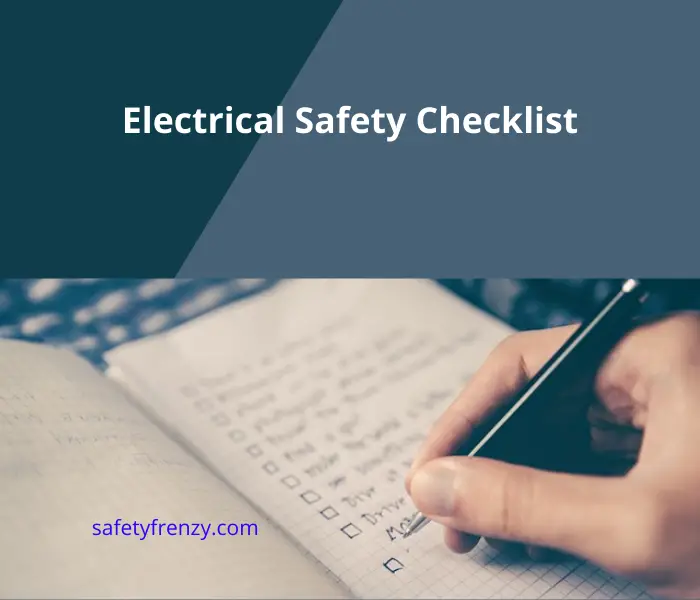This article consists of an electrical safety checklist. Electricity is one of the main cause of accidents and hazards in both homes and workplaces.
While most of the fire-related cases and accidents are caused due to electricity. Therefore Electrical safety is important. It is the responsibility of the landowner to ensure the health and safety of workers from electricity in the home as well as workplaces.
This article consists electrical safety checklist. The checklist helps to determine whether your workers or workplace conditions adhere to electrical safety.
Electrical Safety Checklist
- Ensure lightening protection, connections and measurement value
- Check electrical cords and plugs
- Ensure safe use of electrical devices and equipment
- Use safety signs
- All workers should have and use PPE
- Check earthing system and its resistance value
- Ensure all electrical equipment are unplugged when not used
- Use GFCI for kitchen and bathroom outlets and test it monthly
- Check lighting fixtures installation, distribution and working
- Only authorized electricians are allowed to perform electrical work
- Check electrical isolation system, and ensure the use of LOTO
- Ensure that all heat producing appliances are 3 feet away of any combustible material
- For homes that have kids, make sure to use tamper-resistant outlet
Read also our article: Electrical Lockout Tagout system
Let’s dive into some details
Lightening
One of the main points in the electrical safety checklist is to protect electrical wiring and electrical appliances from lightning. Safety from lightning is important because it consists of thousands of voltages.
To protect power lines from this hazard, safety procedure is adopted. During which a neutral wire is extended over power lines. We refer to it as earth wire.
In case of lightning struck over the power line, it provides a path for high voltage to earth. Similarly, follow the same procedure for electrical wiring and appliances.
This procedure will not only protect electrical equipment but ensure the safety of workers, People in home and workplaces.
Electrical Cords and Plugs
Cords and plugs are the mostly used items in the home. Therefore use it with care. Make sure that all plugs, Extension cords, Surge protectors are completely covered.
If there is any exposed wire or frayed casing remove them immediately to avoid electrocution. Some other tips regarding extension cords are.
- Don’t pass wire under carpets, Doors, and windows.
- If you often need to use extensions, Make a permanent connection and avoid using extension cords permanently.
- Similarly, avoid using high voltage devices using extensions.
- If you are using plugs make sure it fits perfectly in the outlets.
- Use wall outlets for refrigerators, Dryers, Air conditioners, Heaters, etc.
- If there is a basement or any other type of damped area in the home, Use water-resistant extension cords.
The same procedure needs to be followed for workplaces.
Correct use of Electrical Devices at Workplace And Home
Another important electrical safety checklist is the correct use of electrical devices in the home as well as workplaces.
If you are using spark-producing appliances at the workplace. Make sure it is away from inflammable materials.
If devices are not in use, unplug them from the power source.
Buy services of a certified electrician to install safety devices like Fuses, Circuit breakers, and ground fault interrupters.
Using these safety devices can reduce the chances of electrical-related risks and hazards at the workplace.
Read our Article: 13 Tips How to Use electrical equipment safely
Safety Signs at the Workplaces
Workplaces are more prone to electrical hazards. To avoid electrical as well as other accident at the workplace ensure an electrical safety checklist by putting appropriate signs.
When a workplace is equipped with safety signs, It reduces the risk of accidents by 50%.
Besides this create a warning signs list, so that workers know about hazards in advance. A common example is like sparking or flipping a circuit breaker. Dimming of light, Sparking or burning smell are other examples of electrical hazards signs.
Personal Protective Equipment(PPE)
Another important point regarding electrical safety is to make sure the use of proper PPE. Electrical hazards can cause serious injuries and even death. Therefore the use of proper PPE can reduce the risk of hazards.
Read Also: Personal Protective Equipment for Electrical Workers
Summary of Electrical Safety Checklist
A short summary of the electrical safety checklist is shared here.
- Make sure electrical devices like PC’s and other equipment are connected to surge, protectors,
- Check whether electrical outlets plugs, cords, and panels are in good condition.
- Check conductors for broken insulation
- Use electrical cords and extensions for short-range and time.
- When electrical equipment is not in use, turning it off.
- Use circuit breakers and safety equipment.
- Properly check whether the electrical system is properly earthed.
- Use of PPE in workplaces.
you work With Electricity! Don’t leave empty-handed!
Looking to stay ahead of the game in the world of electrical engineering? Subscribe to my YouTube channel and gain access to exclusive content you won’t find anywhere else!
The staff I recommend (Amazon Affiliate Links to products I believe are high quality):
- Economy 120 Volt/60Hz AC Power Source – Step-Down Voltage & Frequency Converters 1800W
- UNI-T Digital Multimeter Tester UT139C
- 50-Amp Extension Cord for RV “100ft”
- Voltage Stabilizer 110/220v
- Hair Dryer “best selling“
- TOSHIBA EM131A5C-BS Countertop Microwave Ovens
Disclaimer: This contains affiliate links to Amazon products. I may earn a commission for purchases made through these links.


